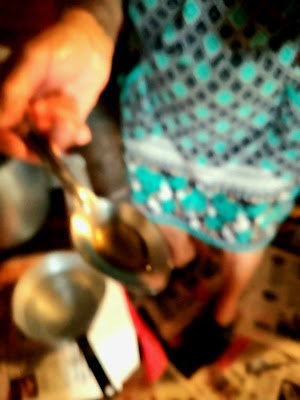Our immediate neighbour Stamata is very proud of her Greek culture and still uses traditional methods of producing food. This Greek method of cheese making has been handed down in her family for generations and I felt blessed to watch .
After milking the goats at the shed, Tasos, the goat herder immediately brings the fresh milk to be processed.
I have had a try at milking...it is much harder than I imagined, not only do you have to hold the animal still, you have to squeeze the teats quite hard and I was afraid of hurting the goat.
The cheesemaking takes place in the lower apotheke/store of the traditional stone house. There are no windows open and the door stays firmly closed to keep the area cool and prevent myges (flies) entering.
Unpasturised, the milk is strained through three muslins, pegged to line a large recycled bucket, to rid the milk of any dirt, hairs etc.
Once strained, Stamata removes two bottles of the milk for later use.
A saucepan of ice cold water is taken from the freezer and into this is poured half a spoonful of 'miehei'. This is a rennet substitute used to curdle the milk. (Apologise for poor photo quality)
This cold mixture is stirred into the milk, covered and left to coagulate for about 1 - 2 hours.
Once curdled the curds and whey are now separated by straining through a muslin.
As yiayia's (grandmas) are still predominantly the childcarers for young children on the island, it is quite common for the children to be involved in such activities. (no hand held/wifi devices here). The perfect education for children to have a great understanding of where food comes from and keeping traditional cultural activities alive.
The curds are hung for the remaining whey to drain out and the soft solid mass of curd is now goats cheese.
The cheese is then rolled in course salt, placed in containers and immediately stored in the fridge.
Of course there has to be a chief taster.
You can't get fresher than this, of which I was gifted a portion to take home from yesterdays batch.
The pale yellow whey is not wasted. It is often fed back to the goats and sheep to supplement their diet with protein.
Mizithra is known as whey cheese. It is a cheese made from using the left over whey.
Do you remember the two bottles of milk that Stamata ladled out earlier?...well this was added to the whey and brought to the boil in a large pan.
The curds and whey mixture is cooled and goes through the same straining process using muslin.
Goats cheese is soft, mildly creamy and can be frozen and defrosted without compromising flavour.
I find goats cheese somewhat bland for my tastes, so I like to layer it in a dish, submerge it in virgin olive oil adding my favourite herbs and spices, garlic or citrus peel. It will last for several weeks in an airtight container in the fridge but it never lasts that long as its so delicious.
.jpg)





















.jpg)








Comments
Post a Comment